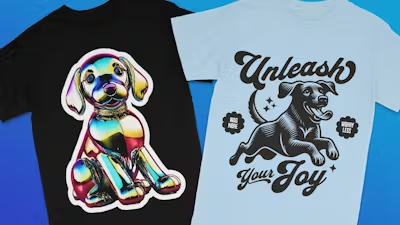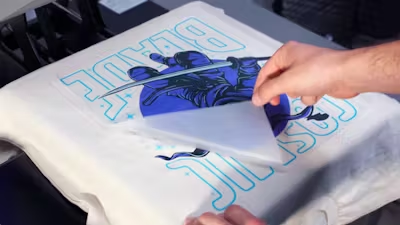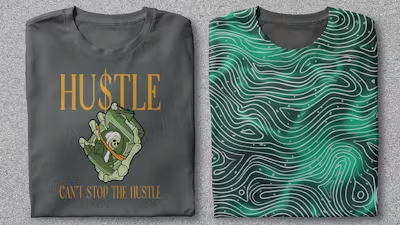Direct-to-Film (DTF) is an innovative printing process that competes with Direct-to-Garment (DTG) printing in clothing customization. If you're an apparel designer, creator, or retailer, understanding the differences between these processes will help you make more money.
What is Direct-to-Film (DTF) Printing?
Direct-to-film (DTF) printing is a clothing customization method that prints a design onto a special film using a high-quality inkjet printer. The film is then placed onto the fabric and heat-pressed, transferring the ink onto the fabric.
The main benefits of DTF transfers are:
Versatility - Direct-to-Film printing performs well on a range of materials like cotton, poly-cotton blends, polyester, and more.
High-Quality Results - DTF printing produces high-quality results similar to traditional screen printing. The designs are vibrant, and the print is crisp
Durability - The printed designs is adhered to the fabric, so it lasts longer
What is Direct-to-Garment (DTG) Printing?
Direct-to-garment (DTG) printing customizes apparel by applying ink directly to fabric. Using a specially designed inkjet printer, DTG is a popular alternative to traditional screen printing.
The main benefits of DTG are:
Highly Detailed Images - Complex designs with multiple colors look great
Soft Feel - Water-based inks are absorbed into the fabric and keep it soft
Fewer Production Steps - DTG printing requires fewer steps to complete a project
Comparing DTF vs DTG

Each project is different, so there isn’t a single best print method. Direct-to-Film and Direct to Garment printing can both produce excellent results, but we’ve found the following based on our experience.
Color Vibrance
Direct-To-Film transfer prints achieve excellent color vibrance, saturation, and accuracy. Alternatively, vivid color has been one area where Direct-To-Garment printing has not performed as well.
Durability
Both customization methods can produce long-lasting prints, but DTF printing tends to produce more durable results. Direct to Film designs are bonded to the fabric using heat, while Direct to Garment ink coats fabric fibers which can weaken over time.
Feel
Apparel printed using both methods have a similar hand feel, but DTG produces a softer texture. The feel of a DTF-printed garment will depend on several factors and sometimes produces a smooth, glossy finish, that feels like vinyl.
Fabrics Types
Direct-to-Film can be used on a wide range of fabrics, including cotton, polyester, and blended fabrics, while DTG performs best on natural-fiber products like cotton. It uses water-soluble ink, which isn’t easily absorbed by many synthetic fabrics such as polyester, nylon, and rayon.
Printing Speed
The production speed of DTG and DTF apparel printing can vary based on a number of factors, but Direct to Film is typically faster. The big difference is curing time for DTG, which can take up to 15 minutes.
Printing Ease
Direct-To-Film is easier than Direct-To-Garment printing. Once the ink is printed onto a DTF transfer, it only needs only to be pressed onto the fabric using heat. DTG printing requires the shirt to be pre-treated with chemicals before printing, and then it needs to be heat cured after printing.
Versatility
Direct-To-Film is much more versatile than Direct-to-Garment printing. Not only can DTF work on most fabrics, but it can be applied to most apparel types. In addition, the ability to position DTF transfers by hand allows for unique print placements that DTG can’t match.
Cost
DTF tends to be less expensive than DTG. Although both printing methods require a significant amount of equipment, additional costs like consumables, maintenance, and staff training give DTF the edge in the cost battle.
This simplified comparison of Direct-to-Film with Direct-to-Garment printing is based on a broad set of assumptions; however, the results can differ based on specific applications. Contact us to learn more about the best option for your project.

Which is Best: DTF or DTG?
Direct-to-Film (DTF) and Direct-to-Garment (DTG) printing can both produce excellent results. While the best option will depend on factors like project requirements, garment, and budget, we recommend DTF as the best option. It’s less expensive and more versatile, while still providing a feel comparable to Direct to Garment printing.
No matter if you’re an individual creator or a small business, Direct-to-Film printing offers significant benefits over Direct-to-Garment.

































